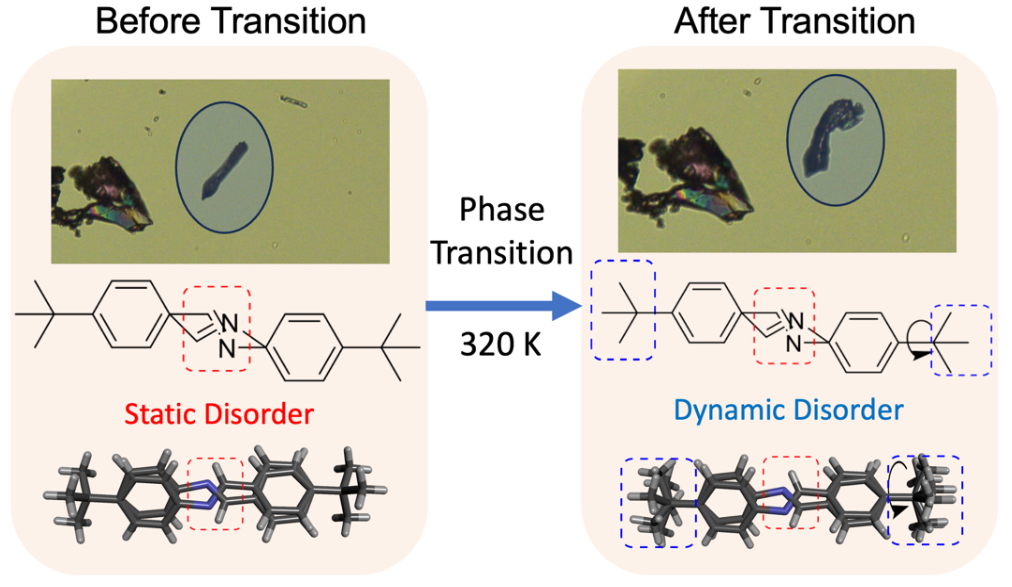| PREVIOUS PRESENTATION | BACK TO PROGRAM OVERVIEW | NEXT PRESENTATION |
Jumping Crystals – Terahertz Phonons Dictate Macroscopic Mechanical Dynamics in Organic Materials
Michael T. Ruggiero
Department of Chemistry, Department of Chemical Engineering, University of Rochester, USA

Figure 1: Optical images of a thermosalient crystal that undergoes a macroscopic shape-shift due to terahertz dynamics.
Over the past two decades, terahertz time-domain spectroscopy has become a valuable technique for the characterization of solid samples, primarily due to its sensitivity to bulk molecular packing arrangements. This has made terahertz spectroscopy a powerful tool for studying crystalline polymorphism, and has also aided in structural determination work. This is because of the extreme and direct sensitivity of terahertz phonons to weak, often non-covalent, interactions in the condensed phase. Additionally, in recent years, the role that specific terahertz vibrations play in a number of important physical phenomena has become increasingly apparent, with numerous studies highlighting how terahertz motions are directly responsible for the proper functioning of materials, ranging from enzymatic catalysis to solid-state phase transformations. In the latter case, there have been several examples where terahertz phonons have been shown to map out the reaction pathways associated with structural changes, often induced by external perturbations such as temperature or pressure [1-3]. Recently, a class of compounds that exhibit macroscopic changes in structure, i.e., the shape and size of micro- and millimeter-sized crystals, have been discovered. Many of these materials exhibit bulk dynamics, for example crystals that literally ‘jump’ when undergoing a phase transformation, which has led to suggested uses for such materials in applications such as mechanical actuators. In this work, we probe the reaction mechanisms in these materials using terahertz spectroscopies, including both terahertz time-domain spectroscopy and low-frequency Raman spectroscopy. Here, specific terahertz motions are identified that are responsible for such phenomena, enabling a direct 1-to-1 mapping of critical processes to a low-frequency vibrational resonance. Overall, this work highlights the powerful role that low-frequency vibrational spectroscopy can play in characterizing and understanding the structures and properties of advanced organic materials.
References
[1] M. T. Ruggiero, W. Zhang, A. D. Bond, D. M. Mittleman, and J. A. Zeitler. Uncovering the Connection Between Low-Frequency Dynamics and Phase Transformation Phenomena in Molecular Solids. Physical Review Letters, 120, 196002 (2018).
[2] M. T. Ruggiero, M. Krynski, E. O. Kissi, J. Sibik, D. Markl, N. Y. Tan, D. Arslanov, W. v. d. Zande, B. Redlich, T. M. Korter, H. Grohganz, K. Lobmann, T. Rades, S. R. Elliott, and J. A. Zeitler. The Significance of the Amorphous Potential Energy Landscape for Dictating Glassy Dynamics and Driving Solid-State Crystallisation. Physical Chemistry Chemical Physics, 19, 30039-30047 (2017).
[3] M. Hutereau, P. A. Banks, B. Slater, J. A. Zeitler, A. D. Bond, and M. T. Ruggiero. Resolving Anharmonic Lattice Dynamics in Molecular Crystals with X-ray Diffraction and Terahertz Spectroscopy. Physical Review Letters, 125, 103001 (2020).
